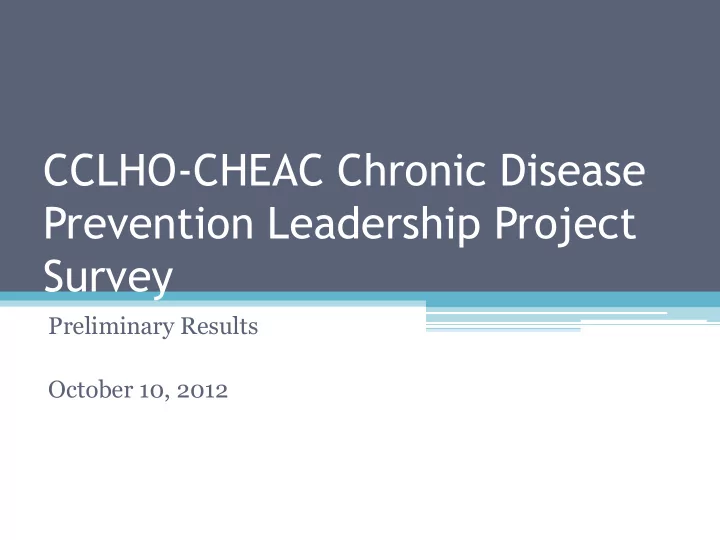

CCLHO-CHEAC Chronic Disease Prevention Leadership Project Survey Preliminary Results October 10, 2012
2 Survey Highlights • 42 responses from city and county health departments • Response rate: 70% • Focus areas • Sugar-sweetened beverages (SSB) • Safe Routes to School (SRTS)
3 Goal: Improve healthy nutrition for all Californians by reducing consumption of sugar-sweetened beverages.
4 Activities to reduce SSB consumption Rethink Your Drink campaign Community education School wellness/nutrition policies strengthened Provider education Healthy vending machine and/or procurement policies outside LHD Provision of consumption data Healthy vending machine and/or procurement policies within LHD Media campaign Assessment of community perceptions Working with corner stores/retailers Implementation of sales ban, size limitation, sales tax or pricing policies 0% 10% 20% 30% 40% 50% 60% 70% 80% 90% 100% Have/Developing activity Interested Not Planning
5 Partners working to reduce SSB consumption Other organizations that serve youth Workplaces Hospitals, healthcare providers and local medical associations Grassroots/Community-based organizations Local Government (elected) officials Sports and recreation programs Food banks Resident Leaders Parent groups UC Cooperative Extension Subcontracting agencies/organizations Faith-based organizations Local Universities/Colleges Local Foundations Retail outlets Funders Senior/Disabled Housing and Centers Local Coalition/Collaborative Local youth No partners 0.0% 10.0% 20.0% 30.0% 40.0% 50.0% 60.0% 70.0% 80.0% 90.0% Percent of LHDs reporting
6 Reported funding sources - SSB No funding Project REACH Housing and Urban Development (HUD) Department of Education (DOE) Robert Wood Johnson Foundation Other private foundation funds First 5 Centers for Disease Control and Prevention (CDC) The California Endowment Department of Health and Human Services (DHHS) Kaiser Foundation Hospitals /Kaiser Community Benefit State Nutrition Assistance Programs Local jurisdiction funding Community Transformation Grant (CTG) Network for a Healthy California 0.0% 10.0% 20.0% 30.0% 40.0% 50.0% 60.0% 70.0% Percent of LHDs reporting
7 Reported Barriers – SSB Activities Lack of funding Political Climate Industry lobbyists Lack of staff County vending policies/monopoly Lack of agency leadership Social norms strong Awarness of the issues around SSB Lack of readiness to start efforts Time intensive to build partnerships/efforts LHD media limitations Lack of enforcement Beverage contracts 0.0% 5.0% 10.0% 15.0% 20.0% 25.0% 30.0% 35.0% 40.0% Percent of LHDs reporting
8 Goal: Increase daily physical activity opportunities for all Californians through promotion of safe routes to school and expanded efforts to create walkable communities and active transport.
9 Activities related to SRTS Community education Partnership with other sectors advocating for expansion of SRTS concept Provision of data School-based policies that promote SRTS - infrastructure changes Participation in SRTS campaigns (County/Unincorporated areas) Conducting mapping assessments Incorporation of SRTS-related support language in County /City General Plan Participation in SRTS campaigns (Local Jurisdictions/Districts) Provider education Complete Streets Task Force that incorporates SRTS Healthy Urban Design Task Force that incorporate SRTS 0% 10% 20% 30% 40% 50% 60% 70% 80% 90% 100% Have/Developing activity Interested Not Planning
10 Partners working to implement SRTS programs and policies School districts Transportation agencies Parent groups Grassroots/Community-based organizations Planning agencies Public Works Local Government (elected) officials Resident Leaders Other organizations that serve youth Subcontracting agencies/organizations Local Universities/Colleges Local Foundations Workplaces Sports and recreation programs Local coalitions No partners Faith-based organizations Air Quality Management District 0.0% 10.0% 20.0% 30.0% 40.0% 50.0% 60.0% 70.0% 80.0% 90.0%
11 Reported funding sources - SRTS Community Transformation Grant (CTG) Local jurisdiction funding Cal Trans Grants Office of Traffic Safety Centers for Disease Control and Prevention (CDC) Network for a Healthy California Kaiser Foundation Hospitals /Kaiser Community Benefit Department of Education (DOE) Other private foundation funds The California Endowment Partnerships with funded entities Local Congestion Management funding Gas tax money Housing and Urban Development (HUD) Department of Health and Human Services (DHHS) Project REACH Robert Wood Johnson Foundation Unsure No funding 0.0% 5.0% 10.0% 15.0% 20.0% 25.0% 30.0% 35.0% 40.0% 45.0% Percent of LHDs reporting
12 Reported Barriers – SRTS Activities Lack of funding Political Climate Lack of staff Safety concerns LHD not previously involved Lack of effective partnerhsips Physical activity not a priority Citywide school assignments not conducive to walking/biking Behavior change issues Lack of agency leadership Turnover of champions Liability concerns 0.0% 5.0% 10.0% 15.0% 20.0% 25.0% 30.0% 35.0% Percent of LHDs reporting
13 Collaborative Efforts • 79% of LHDs participate on coalitions that include SSB consumption reduction efforts • 64% of LHDs participate in SRTS coalitions • 69% of LHDs participate in coalitions to expand SRTS efforts or built environment changes
14 Survey Summary • Statewide inventory of programs and policies related to SSB and SRTS • Coalition participation • Opportunities for partnership & sharing best practices
15 Next Steps • Examine need/opportunity for synergy • Determine how best to address funding and political barriers • Elevate these issues • Going beyond Rethink Your Drink education to focus on environmental approaches • Explore ways to chip away at “political resistance ”
16 Survey Design and Analysis Questions Please contact Danyte S. Mockus, PhD, MPH Epidemiologist, Epidemiology and Program Evaluation Branch County of Riverside Department of Public Health 951.358.5063 Email: dmockus@rivcocha.org
17
18 LHD Coalition Participation LHD participation in SRTS coalition LHD participation in a coalition focused on expansion of SRTS or other efforts to promote physical activity through 10% changes in the built environment Yes 26% No 7% 64% Unsure 24% Yes No Unsure 69%
19 LHD SSB Coalition Participation 2% 19% Yes No Unsure 79%
Recommend
More recommend